CDR after 40 years USD 11 billion of projects
In 1977, after the election of Elias Sarkis as president and the formation of a new government under the leadership of Dr. Salim Hoss, officials wrongly believed that the Lebanese war was over. They decided to establish the Council for Development and Reconstruction (CDR) to rebuild what had been destroyed and to economically and socially jump-start Lebanon.
CDR’s Management
A board of directors consisting of 12 members maximum manages the council. The members are appointed by a decree issued by the Council of Ministers. They include a president, two vice presidents and a secretary-general, who together manage the CDR’s office. These members are full-time employees appointed for a five-year term. As for the part-time members, they are appointed for a three-year term. The council also has a government commission that follows up on its work.
As customary, the president of CDR is a Sunni Muslim and its members are distributed among the other sects. Table No.1 below shows that the CDR has had eight boards of directors since its establishment.
Table No.1: Management Office of CDR (1977-2016).
|
Date |
President |
Vice President |
Vice President |
Secretary-General |
|
31-3-1977 |
Mohammad Atallah |
Adel Khoury |
Sabah El-Hajj |
Joseph Sassine |
|
10-9-1984 |
Malek Salem |
Edward Debas |
- |
- |
|
24-1-1991 |
Al-Fadel Ali Chalak |
Boutros Antoine Labaki |
Ibrahim Mohammad Mehdi Chamseddine |
Nohad Georges Baroudi |
|
10-6-1995 |
Nabil Adnan El-Jisr |
Boutros Antoine Labaki |
Ibrahim Mohammad Mehdi Chamseddine (He resigned in 1977 and was replaced by Yasser Berri) |
Nohad Georges Baroudi |
|
25-1-1999 |
Mahmoud Osman |
Boutros Antoine Labaki |
Yasser Berri |
George Samaha |
|
8-1-2002 |
Jamal Abdel Rahim Itani |
Karim Antoine Yazbek |
Hisham Mohammad Nasser |
Ghazi Haddad |
|
8-12-2004 |
Al-Fadel Ali Chalak (His term ended on 25-8-2006 and he was replaced by Nabil Al-Jisr) |
Alain Najib Kordahi |
Yasser Mostafa Berri |
Ghazi Joseph Haddad |
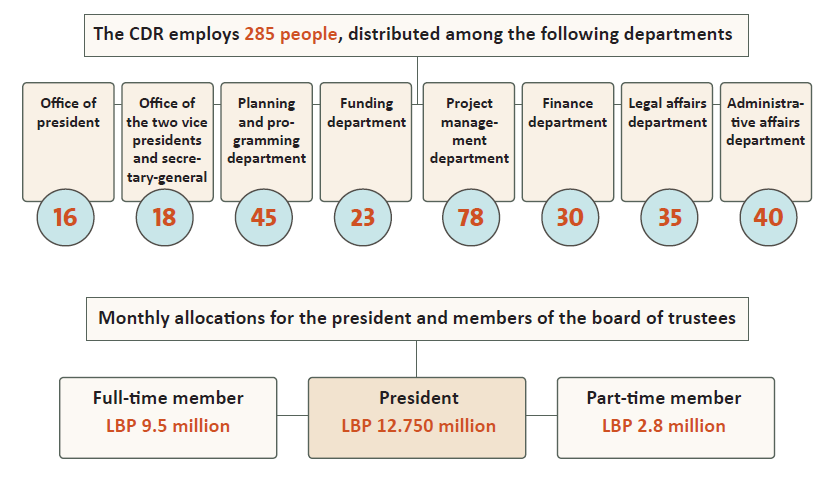
Administrative Budget
A special budget is annually allocated for the CDR from the Council of Ministers’ budget, in order to pay salaries, wages, compensations and other related allowances, as well as to provide office supplies and pay telecommunications, electricity and water charges. This budget soared from LBP 6 billion in 2000 to LBP 38 billion in 2017. Table No.2 below shows the evolution of CDR’s administrative budget (2000-2017).
Table No.2: CDR’s administrative budget during 2000-2017.
Projects Implemented or under Implementation
The CDR is currently implementing dozens of projects throughout Lebanon. Table No. 3 below shows a sample of USD 710 billion’s worth of projects.
Table No. 3: Some of the CDR’s Projects.
|
|
Project |
Cost (USD million) |
|
|
Mar Chaaya-Al-Atshana-Ain Alak road project, Metn |
29.4 |
|
|
Renovation of Ain El-Hour-Daraya-Aanout-Zaarouriyeh junction, Chouf |
12 |
|
|
Jal El-Dib highway |
74 (including acquisitions of USD 22 million) |
|
|
Construction of Baabdat-Metn-Bchellama road |
52 (including acquisitions of USD 6.5 million) |
|
|
Mayrouba-Nahr El-Dahab (Gold River)-Jouret El-Termos |
27 |
|
|
Project |
Cost (USD million) |
|
|
Daraoun-Harissa road project |
8 |
|
|
Completion of Ehmej-Laqlouq road |
9 |
|
|
Complementation of Hazmieh connector |
3.2 |
|
|
Ehden-Mar Sarkis Spring road |
8 |
|
|
Tannourine El Tahta-Tannourine El Faouqa road |
18 |
|
|
Main roads |
27 |
|
|
Renovation of public high school in Aley |
4.5 |
|
|
Kfarselwan school project |
2 |
|
|
Tyre serail |
7 |
|
|
Halba serail in Akkar |
7 |
|
|
Baalbeck serail |
7 |
|
|
Palace of justice, Nabatieh |
9.5 |
|
|
Construction of government buildings in Chehim, Chouf |
7.5 |
|
|
Construction of an additional building in Roumieh Prison and a new courtroom |
8.1 |
|
|
Establishment of Deir El-Qamar Governmental Hospital |
10.4 |
|
|
Karantina Hospital |
2 |
|
|
Sewage project in Chehar El-Gharbi |
14.5 |
|
|
Implementation of sewage networks in Tyre |
39 |
|
|
Sanitation in and around Jezzine |
5 |
|
|
Supplemental appropriation for sewage and drinking water project in some Baalbeck villages |
10 |
|
|
Sewage project in Baalbeck’s Al-Labwa region |
15 |
|
|
Completion of sewage project in Western Beqa’a |
20 |
|
|
Supplying South Lebanon with Litani River water for irrigation and drinking purposes |
54 |
|
|
Drinking water project in Hermel Qada’a |
27.2 |
|
|
Waterworks in Aiha-Rashaya |
2.5 |
|
|
Additional waterworks in Jabal Amel |
29.5 |
|
|
Water systems in Hebarieh, Hasbaya |
14.5 |
|
|
Construction of water line from Al-Arayesh tank in Zahle |
6.5 |
|
|
Landslide in Kfarnabrakh (Emir Bashir Water Canal), Chouf |
5.2 |
|
|
Financing a part of infrastructure in Beirut |
28 |
|
|
Acquisition of Tyre-Ras El Ain waste mountain |
2 |
|
|
Filling of lands at Tripoli Port |
24 |
|
|
Railway between Tripoli and Syrian border |
80 |
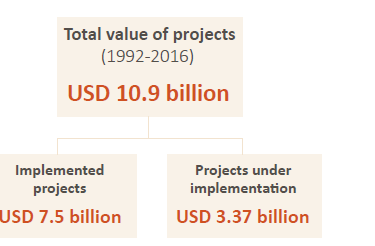
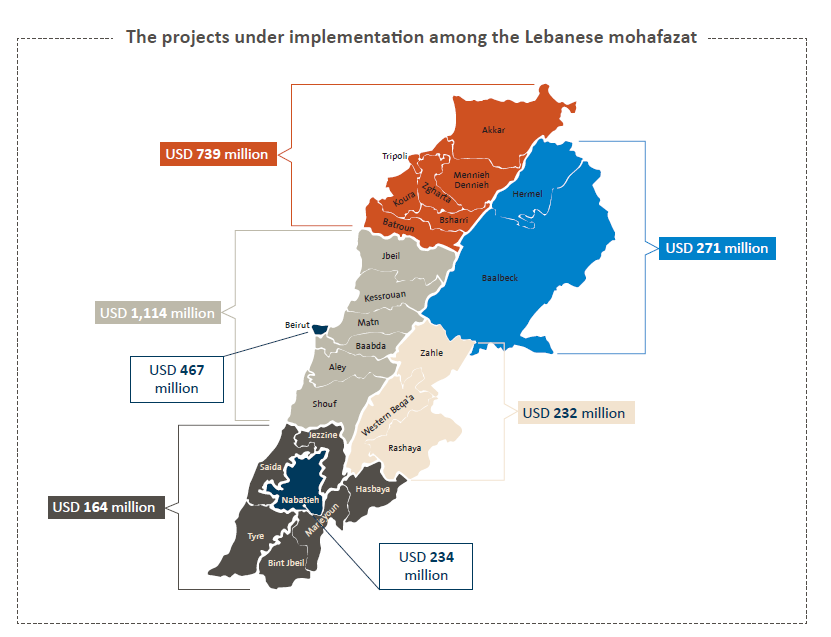
As for the implemented projects, they are distributed according to the aqdiyah as shown in Table No. 4 below.
Table No. 4: Distribution of projects implemented by CDR.
|
Qada’a |
Value of Projects (USD million) |
|
Beirut |
739 |
|
Baabda |
420.3 |
|
Metn |
580.3 |
|
Chouf |
216 |
|
Aley |
163.6 |
|
Kessrouan |
218 |
|
Jbeil |
165 |
|
Mount Lebanon Total |
1,763.2 |
|
Tripoli |
571 |
|
Koura |
77.7 |
|
Zgharta |
74 |
|
Batroun |
171.3 |
|
Akkar |
265.6 |
|
Bsharri |
95 |
|
Mennieh-Dennieh |
168 |
|
North Lebanon and Akkar Total |
1,422.6 |
|
Saida |
286 |
|
Tyre |
314.5 |
|
Jezzine |
64 |
|
Bint Jbeil |
133 |
|
Marjeyoun |
137.6 |
|
Nabatieh |
138 |
|
Hasbaya |
128.3 |
|
South Lebanon and Nabatieh Total |
1,201 |
|
Zahle |
121 |
|
Western Beqa’a |
127 |
|
Baalbeck |
306 |
|
Hermel |
55.2 |
|
Rashaya |
23.8 |
|
Beqa’a, Baalbeck and Hermel Total |
633 |
|
Overall Total |
USD 5,758.8 billion |
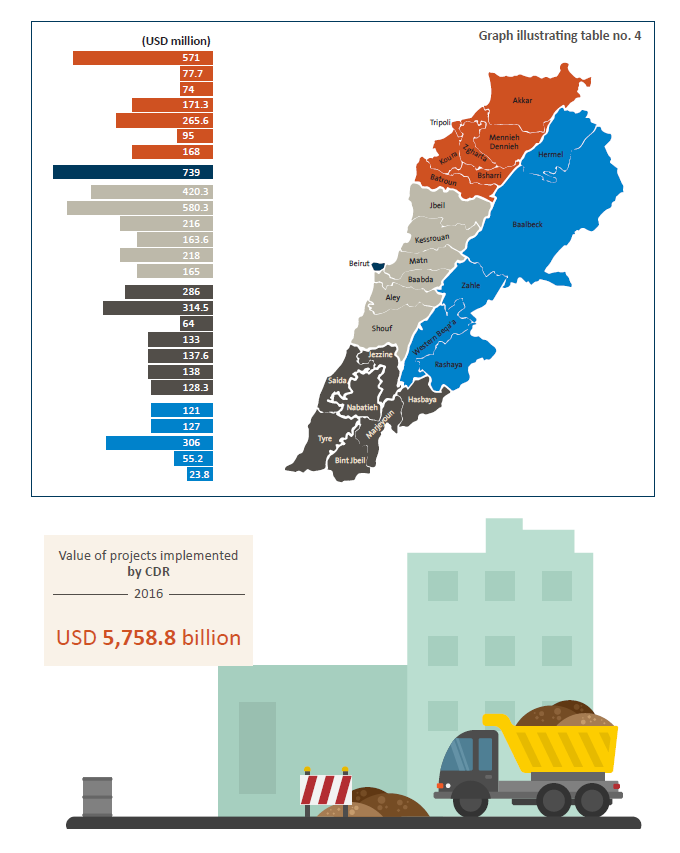
Projects Distribution by Sectors
The projects implemented between 1992 and 2016 amounted to USD 10.880 million. They were distributed among 13 service sectors and the largest share was for the transport sector (road construction, highway construction, etc), representing about 30% of the total value of projects. Table No.5 below shows how the projects were distributed by sectors.
Table No. 5: Projects by sectors.
|
Sector |
Value (USD million) |
Ratio % |
|
Transport |
3.236 |
30 |
|
Electricity |
1.478 |
13.6 |
|
Drinking water |
1.333 |
12.2 |
|
Education, Higher Education, Culture, Youth, and Sports |
1.286 |
11.8 |
|
Sewage |
897 |
8.2 |
|
Landline |
797 |
7.3 |
|
Agriculture and Irrigation |
505 |
4.6 |
|
Infrastructure Projects |
504.5 |
4.6 |
|
Health |
345 |
3.2 |
|
Project management and capacity building |
127 |
1.1 |
|
Land and Environment |
127 |
1.1 |
|
Other sectors |
244.5 |
2.1 |
|
Total Value |
10.880 |
100% |
The CDR has replaced many ministries and been granted great powers. Yet, its achievements and aspirations have been disappointing and made most of the Lebanese pay tribute to the work of ministries.



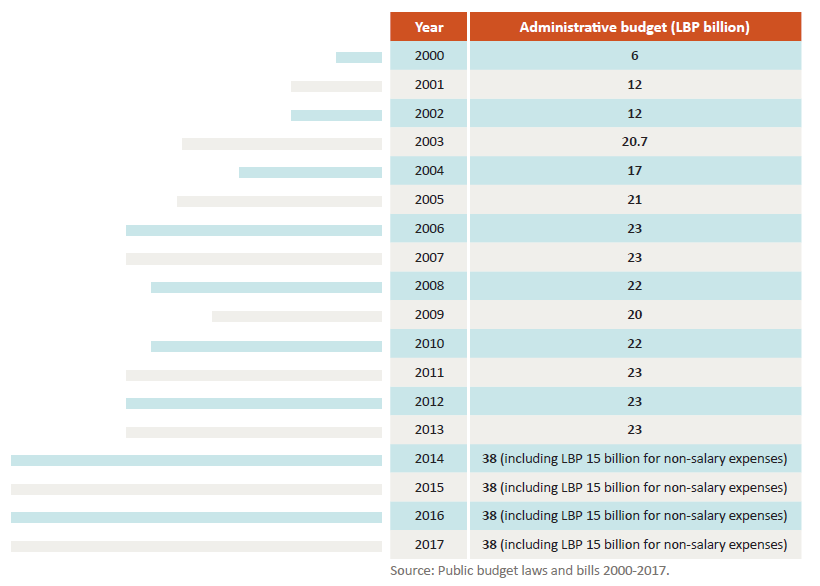






Leave A Comment